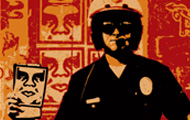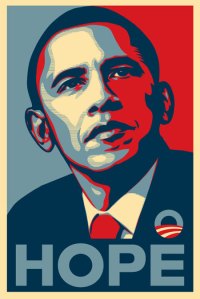
Shepard Fairey and poster
Kudos to Boston’s Institute for Contemporary Art for mounting a spectacular 20-year restrospective of Shepard Fairey’s work–which opened for members on Feb. 4, 2009.
Entitled “Supply and Demand,” the show, which runs through August 16, 2009, includes some 200 stickers, posters, portraits, and murals, including the now iconic Barack Obama “Hope” poster which has found its way all over the world.
The show traces Fairy’s work to the 1980s when, as a teenager in Charleston, South Carolina, he was attracted to counter-cultures like skateboarding and punk rock–and their stickers–and began making his own.
As a student at the Rhode Island School of Design in 1988, Fairey instructed a friend in making a paper cut stencil using an image of Andre the Giant, who a popular figure in the World Wrestling Federation, am ICA handout explains. The two then paired the face with the phrase “Andre the Giant has a posse,” and over the next six years, produced more than a million hand-printed and cut stickers, which Fairey sent to friends who posted them all over the US.
(On a huge campaign billboard, he also used one to cover the face of then-Providence mayor Buddy Cianci, who says sheepishly in an accompanying video that this disturbed him because it was defacing property. It’s all the funnier in hindsight, knowing that Cianci was later jailed on corruption charges).
Toward the end of the 1990s, Fairey started to challenge what the ICA calls the “corporate advertising machine…He asks us to consider whether the so-called ‘public space’ is really public.
“Most advertising takes an ‘in your face’ approach to sell or influence consumers. Fairey’s Obey giant campaign–which features the word “obey” and other slogans [on a variety of images ]sells nothing but its mysterious imagery, ambiguity and underground appeal has made passers-by worldwide question the visual noise that crowds our streets”–as well as the insidious advertising messages used to command us.
One large room features portraits–some of which incorporate the “obey” command. One print portrays George W. Bush as a vampire, with blood running out of his mouth. Other portraits feature musicians, guerilla leaders, gang members, Muslim women, and additional political leaders.
A highlight is Fairey’s iconic “Hope” portrait of Barack Obama, which “has spread like a virus on TV, in print and online, on t-shirts and buttons, and guerilla-style on streets all over the globe.”
The poster seems particularly poignant with Obama, now in his third week as President, facing not only a terrible economic situation and two wars, but also the disintegration of a seemingly promising leadership team whose members betrayed him and us for personal greed.
The exhibit, co-curated by guest curator Pedro Alonzo and Emily Moore Bouillet, former assistant curator at the ICA, and sponsored by Levi-Strauss culminates with a set of four stunning, intricately designed, murals.
Commissioned by the ICA, the murals, along with the other components and the exhibit as a whole are inspirational.
Not only do they each convey provocative messages about individuals’ relationship to power and commerce, but they embody and communicate an individual’s ability to follow his creative instincts and passion to achieve artistic and, ironically, commercial success.
*
Having arrived on time for the opening, I didn’t have to wait in line–but in a lovely wine reception on the second floor, was told that people who got there early had to stand outside in the cold until the official opening time. in leaving, at around 8 PM, I had to cut around long, winding lines of people in the lobby who were waiting to sign in.
My only beef was the lack of beef…the wine was fine, but my companion, Mark H. and I would have appreciated a few chips to go along with it. Next time, I’ll definitely arrive on time–and eat before I go.
AMH
New Cambridge Observer is a publication of the Harris Communications Group of Cambridge, MA.

